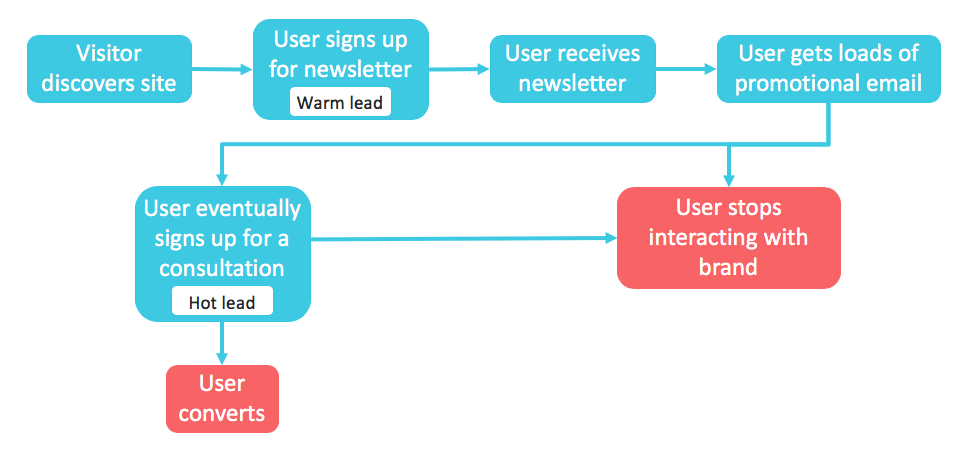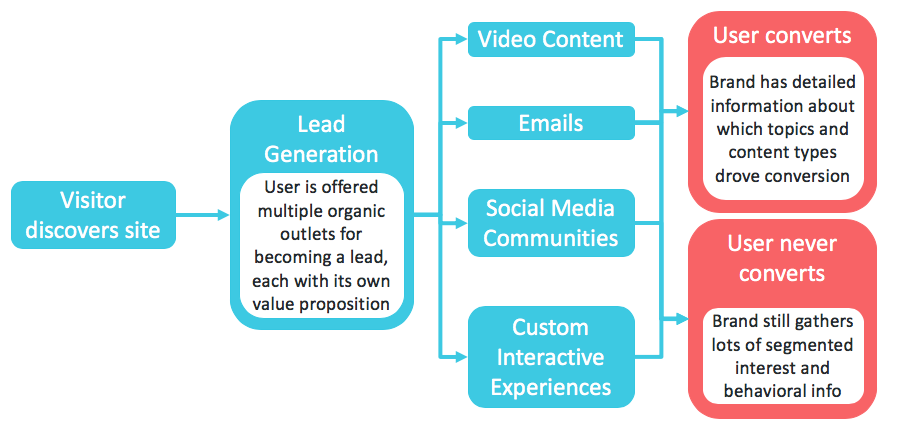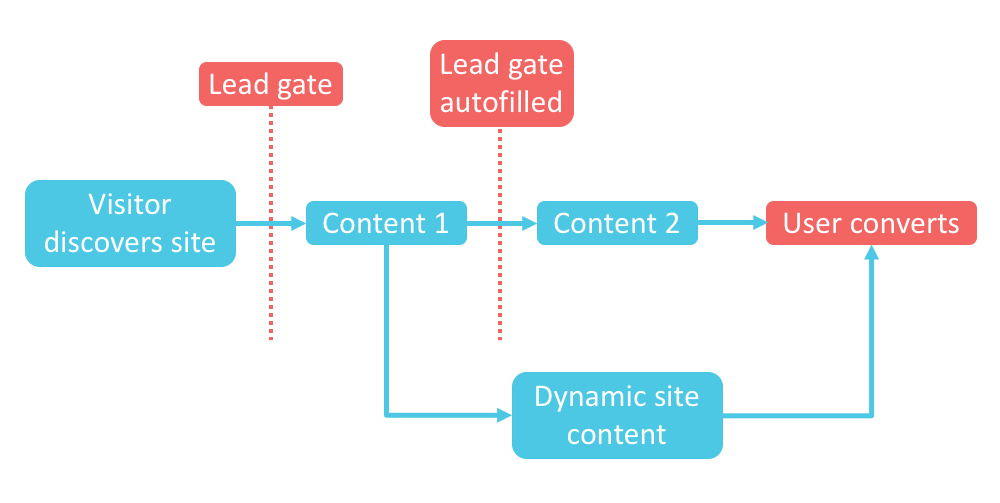For Google News
Strategies for Driving Lead Generation with Your Content Marketing
By Kyle Harper on October 18, 2018
The demand for more and better leads may be a constant for marketers, but the rise of digital marketing has dramatically changed our approach to lead generation. After the growing pains of full screen pop-ups for opt-in, mail-in sign ups, and some extremely aggressive follow-up campaigns, we're currently in a much better place. Many businesses now understand that effective lead generation can't be forced; it has to be nurtured.
The user-oriented mindset of content marketing presents an opportunity to reshape lead generation strategies to not only encourage users to convert, but also to gather useful information about our audience-all without sacrificing the quality of the content experience.
The Anatomy of a Lead
If we're going to understand how lead generation fits into a larger engagement marketing strategy, we have to understand how leads themselves have changed.
For many marketers, it's hard to break away from the mid-'90s, Glengarry Glen Ross sense of what a lead can be: just a list of names and numbers for salespeople to call. In reality, today's leads are much more layered, having grown up alongside more sophisticated marketing segmentation. Leads don't have to be people screaming their intent to purchase; they can be newsletter subscribers, logged-in users, or converted customers waiting to be re-engaged.
Image attribution: Katrina Berban
The key way for marketers to reorient their thinking is to stop focusing on whether leads are "hot" or "cold." This sales-centric way of thinking keeps us as brands focused only on distance from a purchase, which doesn't necessarily fit with a more organic content experience. Rather, I've begun working with teams using the idea of "curious" versus "urgent" leads.
Urgent leads fall into our traditional understanding of lead generation. These are people who have filled out forms asking for a consultation, hopped on the phone to inquire about buying options, or have otherwise directly expressed interest in making a purchase. Businesses that have means in place to collect urgent leads tend to also have the retailing or selling apparatus in place necessary to help them buy.
Curious leads, however, are an enormous opportunity for marketers. These are visitors to your site who have indicated additional interest in your brand beyond your regular user, most often by engaging with your content marketing. Newsletter mailing lists are one of the few common ways I see marketers engaging with this type of lead. This visitor group might give your brand lots of information, but in return they expect more information or an experience-not your product.
This is where a large disconnect exists for many of our brands: We try to treat curious leads like urgent leads.
Curious leads can have enormous utility for marketers, but only if the people submitting to your lead generation strategy don't feel like they're being exploited. Sending constant promotions to a newsletter list or following up on a white paper request with a call isn't just ineffective-it can turn people off your brand entirely.
Instead, curious leads should be seen as an opportunity for content marketers to understand audience trends and to better serve tailored content experiences.
Lead Generation Model One: Diverse Avenue
Diverse Avenue is a style of "always on" lead generation that aims to be unobtrusive and rewarding throughout the user experience. Unlike traditional lead generation where users are pushed down a funnel towards conversion, a Diverse Avenue model offers visitors to your site multiple pathways for reward and self-identification, without the expectation of a purchase.
Let's return to newsletters again to consider how this might look. On a traditional lead generation site, your user might have a two-step funnel that looks like this:

There are two key weaknesses with this model:
- By concentrating all of your leads through a single point of entry, you're forced to request more information from respondents if you want to do any segmentation with them later. The more information you ask, the less willing visitors will be to complete your form.
- By positioning your content as direct step towards conversion, you risk building content with sales in mind, rather than your visitors' needs.
To combat these issues, we can diversify the number of avenues a visitor has for opting in and make it so these steps aren't directly tied to the conversion process. It might look something like this:

This updated model moves us away from a sales orientation and towards an engagement marketing strategy. A few key elements to note:
- Different avenues for opting in mean that interest-based segmentation can be built into your process, removing the need to ask for information from a user.
- The more segmented your opt-ins are, the more ability you have to serve unique content that meets your audience's interests. Creating specific experiences based on points of opt-in is one of the strongest ways that content marketers can support curious leads.
- With the right tracking in place, your brand can use multiple opt-in points to better understand elements of your audience, including common points of interest, average consideration time before conversion, or preferred channels of communication.
There are distinct challenges with this approach, however. Even executed perfectly, Diverse Avenue requires content and upkeep in direct proportion to the amount of segmentation you're hoping to achieve.
The more points of opt-in you offer, the more work it takes for your team to keep it high quality. This results in a careful balancing act where you have to keep meaningful experiences and administrative creep in check. But supported correctly and rolled out with intention, Diverse Avenue can give your brand an enormous amount of information on your audience while also offering uniquely engaging marketing.
Lead Generation Model Two: Welcoming Gates
Welcoming Gates is a model that takes one of lead generation's least enjoyable tools and turns it into a technique for improving user experience. Unlike the Diverse Avenue approach, Welcoming Gates work by collecting segmentation information about your user early in their visit to your page, and then using this data to dynamically change content recommendations, page content, and other site or marketing activities to match their needs. Done correctly, this model can gather highly detailed information for your brand, while offering highly curated experiences for your audience.
All of this is centered around the "content gate." It's a technique you're likely familiar with if you've ever tried to download a handful of white papers from a site. By asking a visitor to provide information about themselves upfront in return for high-value content, you're typically able to request more information in a slightly longer format. This comes with the risk, however, of creating friction that pushes users away.
A classic model for gated content use might look like this:

The goal here is so oriented towards driving a conversion that the brand just accepts a high attrition rate. There are two primary factors that drive this fall-off:
- Users don't believe the amount of information they're being asked to give lines up with the value they're receiving in return.
- A less thoughtful site setup results in users repeatedly filling out this information, slowing their experience to a crawl until they leave.
The Welcoming Gates Model addresses both of these issues by building the site content experience so that users only enter information once. In doing so, their site experience becomes tailored to them. It looks something like this:

A Welcoming Gate setup will require some initial heavy lifting by your development team. Capturing and referencing user information at the point of entry requires some cookie storage and monitoring tools, but once in place, it serves as a highly effective tracking point.
Start by using lead information to autofill other lead generation forms on the site, then use this information to serve custom content recommendations, and then eventually consider having dynamically served pages based on the information provided by your user.
Redefining Lead Generation Strategy
If you've identified lead generation as a marketing priority, you've only got the beginning of your strategy in place. The question you should be asking next is what kind of generation you're trying to embrace. Are you actively trying to shovel hot leads into a sales apparatus, or is it more likely that you have curious leads who would benefit from tailored content?
The models provided here represent two extremes in the service of supporting curious leads-most brands will find that a mix of these two lead generation strategies actually works best for their particular funnel.
Whatever balance you strike with your content, the goal should remain the same: use any information you gather to inform your business and improve the experiences of your visitors. Your content served to the right people at the right time will do the rest.
For more stories like this, subscribe to the Content Standard newsletter.
Featured image attribution: Matt Zhou


